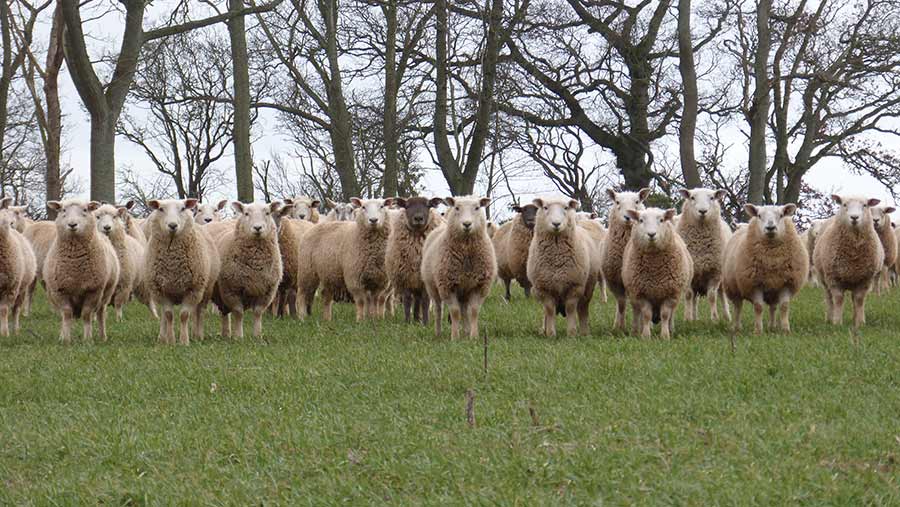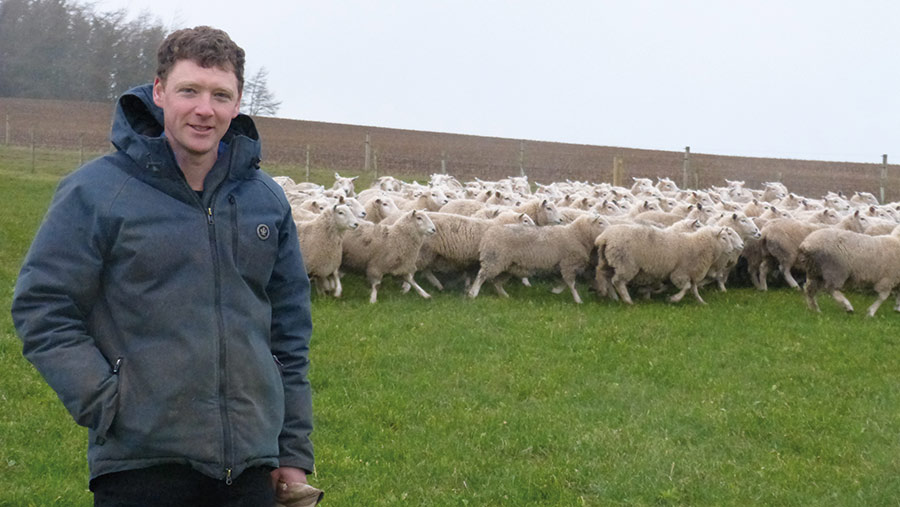The system that helps a sheep unit save £30,000 on feed
 © MAG/Michael Priestley
© MAG/Michael Priestley A culture of encouragement and autonomy has helped a Scottish Borders farmer maximise the value of a skilled stock manager and save tens of thousands of pounds.
The sheep system at Overhowden, Oxton, near Lauder, has maintained output while removing costs since Alex Robertson employed Joss Jones in 2018.
See also: How Borders flock is using targeted selective treatments
For the same output of 1,550 lambs, the farm has:
- Cut 90-100t of ewe rolls out of the system
- Cut 30t of creep from lamb finishing
- Cut at least 250 bales of silage for the same flock size. About 600 bales are needed each year.
- Cut fertiliser use from 41t to 25t.
Farm Facts
- Paxton South Mains is a 350ha (865-acre) lowland arable farm
- Overhowden is a 200ha (494-acre) upland grassland farm
- 90 Hereford- and Angus-cross suckler cows
- 850 ewes plus 300 ewe lambs tupped
- Sell store cattle privately
- Sell prime lambs deadweight
Steady change

Joss Jones at Overhowden © MAG/Michael Priestley
After five years of shepherding at sheep stations in New Zealand, Mr Jones moved into the farmhouse at Overhowden as stock manager.
Overhowden is 45min away from Paxton South Mains, near Berwick, where Mr Robertson has a 350ha (865-acre) arable and beef farm.
The direction of change since his arrival has seen mature ewe size drop by 10-15kg, a move to outdoor lambing and a less input-heavy system. But Mr Jones stresses he inherited a productive setup.
“The flock performance was good, with the Mule ewes rearing more than 180% and the crossed ewes producing high-value lambs,” he says.
“For the first couple of years, I tried to add to the system we already had. The difficulty with changing too much at once can be you don’t know what works and what doesn’t.”
System targets 2,000 lambs
- Previous system: 850 ewes rearing 180-185% = 1,550 lambs sold including 120 pet lambs. Total ewe weight was more than 68,000kg, with an average weight of 80kg.
- Current system: Transition to a smaller 68kg mature size (total 57,800kg) lambing outdoors and rearing 165%. In addition, 300 ewe lambs are rearing 110%, which compensates for the reduced weaning percentage of the ewes lambing outdoors. A maternal ram serves the ewe lambs after one cycle with the ewes.
- Future plans: Lift numbers to 1,000 68kg ewes to the tup to return total ewe flock weight to previous levels, plus tupping hoggs. Aim to rear a total of 2,000 lambs a year.
Trade off
While the ewes require less cake, baled forage and fertiliser, the system has added in forage crops and an extra cut (or two) of silage, which has increased contractor costs.
Instead of one bulky mid-summer cut, a cut is taken in late May/early June and a second in mid-July, with an opportunity cut of 50 or so bales in late summer.
In 2017, the sheep needed £33,000 of cake, which had been reduced to £2,500 of soya in 25kg bags in 2021. In today’s money, the total savings are more than £50,000.
“Nothing we are doing is new, it’s just new to us,” says Mr Robertson. “I largely leave Joss to it, but he knows we can talk whenever we need to.”
Mr Jones explains some of the big steps taken in changing the system:
1. Use the cattle as a grazing tool after sheep
Previously, cattle grazed their own fields and were set stocked.
One of the first alterations was to use the cows as a grazing tool behind the sheep, trying to stick to a leader-follower system, giving sheep and lambs the pick of the grazing.
Now the farm runs four eight-paddock rotations at Overhowden. Ewes have two days to graze, and cows have two straight afterwards.
2. Develop infrastructure and reduce field size
A new 12m-wide, 1.25km laneway with a crushed stone base runs alongside a stone wall that leads west to the top of the hill at the back of the farm.
This took three winters to build and helps link the long, thin farm together. It is used to gather ewes and cattle and rotate them round the farm.
Every field is now a maximum of about 6ha (15 acres). Five larger fields were halved, with five-wire fences and posts every 10m apart.
Three-wire reels can be used to further divide paddocks and drag troughs and static troughs have been added.
3. Change to smaller sheep breed that thrives off forage
The farm has switched from a heavier Scotch and Cheviot Mule (75kg) flock using Suffolk and Texel terminal sires and retaining some Suffolk-crosses (85kg) to a self-replacing flock using smaller Romney-cross (65kg) ewes.
About 100 five-year-old Romneys came from David MacTaggart, Hallrule Farms, and rams are bought from High Country Romneys, Herefordshire.
This has been done to harness genetics based on forage-only systems lambed outdoors.
4. Limit demand on the grazing platform in late summer
Lambs are now weaned 30 days earlier, at 90 days, and 350 Suffolk crosses are transitioned on to 8ha (20 acres) of Redstart to help finish them, rather than using concentrates.
Getting lambs away sooner allows more of a wedge of grass to be built to take ewes through the winter cheaply.
Grass is measured with a rising plate meter in spring and autumn to assess farm covers. Average farm cover of 2,000kg/ha is the target by mid-November. In 2022 1,980kg was achieved.
Grazing of winter wheat on the lowland farm at Paxton has finished lambs to about 45kg. Mr Robertson sees this as “free feed”. A trial of 78 2021-born lambs worked well and 200 have been wintered on wheat this year.
5. Extended winter rest periods for paddocks
Lambing paddocks on the more sheltered eastern side of the farm are given at least 100 days rest to avoid overgrazing grass late in the year and taking energy out of the plant root reserves.
This follows a 75-day rotation where sheep are spread out and given ample good grass to help prolificacy around tupping, having previously been mobbed up.
Raddle markers are changed every five days for the first cycle (about 90% of ewes). The flock is then run as one mob and ewes are drafted five days before lambing date.
This minimises the need for set stocking and leaves paddocks more time to grow in spring.
The 75-day rotation ends in late January/early February when ewes are sheared (once a year) after scanning and housed on silage for four-to-five weeks to rest the grass.
Raddle colours are topped up at this point. Straw comes from Paxton South Mains.
A month before lambing, twin-bearing ewes go on to a sacrifice field and fed better-quality silage ad-lib.
They are walked to a nearby strong grass field daily for a few hours to graze 2kg of fresh grass for 28 days and back fenced on to about 2.5t of grass dry matter.
6. Focus on timing to produce better-quality silage
The aim is to cut grass before the heading date to produce silage of 11.5MJ/kg metabolisable energy.
In this way, silage and early spring grass provide all the energy the ewes need, and soya can be fed at 100g for every lamb carried for the decreasing number of Suffolk cross ewes still lambed indoors.
